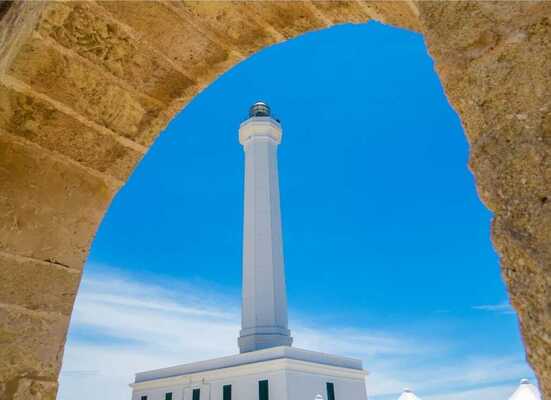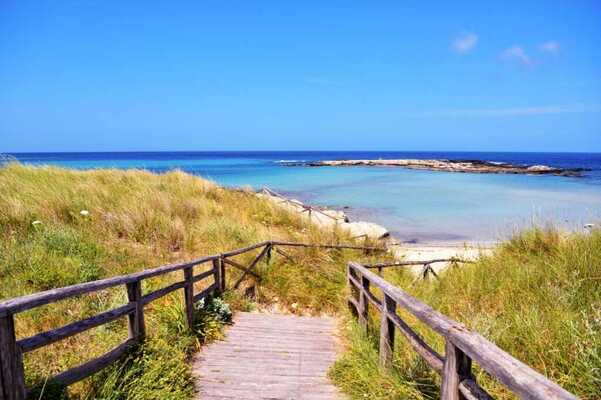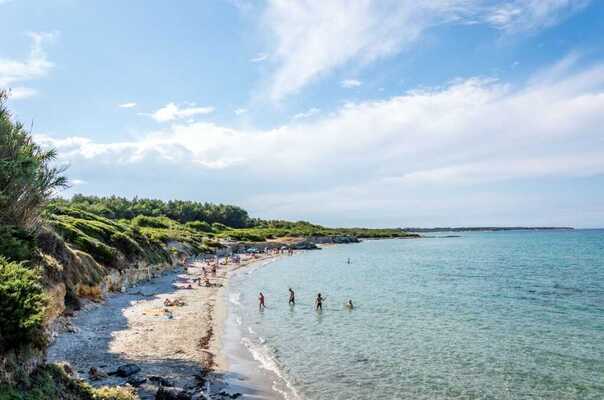Santa Cesarea Terme
In the splendid setting of the Otranto Canal with its crystal clear waters, stands an ancient village with a multifaceted charm: Santa Cesarea Terme.
50km from Lecce, located on the south-eastern coast of Salento, it represents one of the most popular Salento destinations for travelers seeking relaxation and well-being. This is also thanks to the beneficial thermal waters that flow from the subsoil which are, in fact, a true elixir of beauty and health.

Historic center of Santa Cesarea Terme
The beauty of the rocky coast overlooking the sea is combined with the suggestions of a town with an Art Nouveau atmosphere and renowned spa. In the intermediate area you discover the characteristic town lined with beautiful villas, including Villa Sticchi and Villa Raffaelli, while, in the upper part, with the surrounding countryside where you can admire numerous vineyards and olive groves, which houses some sites of high historical and landscape interest like the fourteenth-century Mother Church of the Sacred Heart.
Going further up the hill, you will reach a grove of Aleppo pines where there is also a small playground and the Belvedere. Here you will admire the entire coast up to Leuca at a glance and, on days when the sky is clearer, the high Albanian mountains are clearly visible from the other side of the sea.
History of Santa Cesarea Terme
Officially, Santa Cesarea Terme was born as an autonomously administered municipality only in 1913. This splendid municipality in Salento blossomed late, due to the numerous attacks by the Saracens along the coasts.
In the sixteenth century, continuous clashes distanced the population and made the creation of an urban center difficult. Only in the nineteenth century were the caves and sulphurous waters with healing properties rediscovered, transforming Santa Cesàrea Terme into a renowned hydrothermal town, adorned with splendid noble and bourgeois villas. Over time, between the nineteenth and twentieth centuries, the village grew so much that it became larger than the nearby towns and thus the need for adequate administration arose.
Popular legends
The beneficial waters are also the protagonists of some of the most fascinating legends of popular tradition.
Santa Cesarea Terme takes its name from its patron saint; popular tradition says that Cesaria Vinciguerra was born in the 14th century. The Saint lost her mother when she was still a teenager, and to escape the inappropriate attentions of her father she took refuge in a cave in the Castro marina, under a rocky hill near Otranto, around which the town was later born. Her father, in an attempt to kidnap her, was swallowed up by the waves, and since then a spring of sulphurous water has flowed from that very point. However, the young woman decided to continue her life in that cave, dedicated to total dedication to God. After her death, a church was built where pilgrims could go on pilgrimage.
According to another legend, the waters of Santa Cesarea have mythological origins linked to the defeat of the Leuterni on the Phlegraean Fields by Hercules. Some of these giants, who are said to have been tempered in fire and sulphur, managed to escape from the demigod and hide in the Salento caves in the Santa Cesarea area, inside which, from the dissolution in the water of the substances generated by their bodies in decomposition, sulfur springs were born.
Thermal baths of Santa Cesarea
If Santa Cesarea Terme has become, in a certain sense, the capital of Salento wellness, it is thanks to its beneficial salt-bromine-iodic-sulphurous-fluorinated waters that flow from four natural sea caves (called Fetida, Sulfurea, Gattulla and Solfatara) to a temperature of around 30 degrees.
This type of water is considered a real asset from a medical point of view as it boasts high therapeutic properties. They are particularly effective in the treatment of respiratory tract pathologies, they are able to relieve pain and disorders of the musculoskeletal system, treatments of epidermal pathologies, up to baths and massages, and thanks to the presence of bromine, they boast sedative effects useful in cases of stress, fatigue, agitation and insomnia and, for some years, they have also been used in the field of aesthetic medicine.
At the facility it is also possible to enjoy special treatments which, in addition to water and mud, also exploit other natural, zero-mile products. Try the oil and olive leaf scrub, the treatment based on honey and Negramaro wine or sea salt, and the thermal showers.
There are also bathing establishments:
- Il Caicco is a historic lido, terraced on several levels on a cliff overlooking the sea.
- The Sulfur Pool, with a 30° thermal water pool with a view and access to the sea by a staircase carved into the rock.

Events
- Among the events of Santa Cesarea Terme, the most important one, in the month of July, is the “Blue Night”. An alternative version of the traditional white nights, with shops and various museums open. Characterized in this case by the theme of energy saving, it is in fact celebrated on a full moon night, and therefore naturally brighter. The whole night is animated by a series of shows, plays, street artists, cabaret and tastings of typical dishes.
- The Patron Saint, who also gives her name to the city, is particularly loved. Every year on 11 and 12 September the Patronal Feast of Santa Cesarea Vergine is held. The celebration begins with a procession that winds through the streets of the city, and continues at sea, with the blessing of the waves and a procession of boats that reaches the cave where the Saint is said to have spent most of her life, dedicated to prayer.
- Don’t miss the Palio of Santa Cesarea, during which the best “Venetian rowing” is awarded. It consists of rowing standing to see if there is sufficient seabed for navigation). There is no shortage of spectacular fireworks, tastings and the traditional “pizzica salentina” (typical Salento dance).

Santa Maria di Leuca: de finibus terrae
The place where the Adriatic Sea and the Ionian Sea meet: Santa Maria di Leuca, the tip of the heel of Puglia, is a unique and magical place waiting to be discovered. With its lighthouse, basilica, caves and nineteenth-century villas, this place will leave you speechless.

Porto Badisco: a paradise three steps from Otranto
Seaside location between Otranto, Santa Cesarea Terme and Castro, according to legend, linked to Virgil's narrative, Aeneas landed here together with his father and son.

Baia dei Turchi
The sandy and uncontaminated bay with clear waters and surrounded by a Mediterranean scrub cliff has nothing to envy of international tourist destinations.
